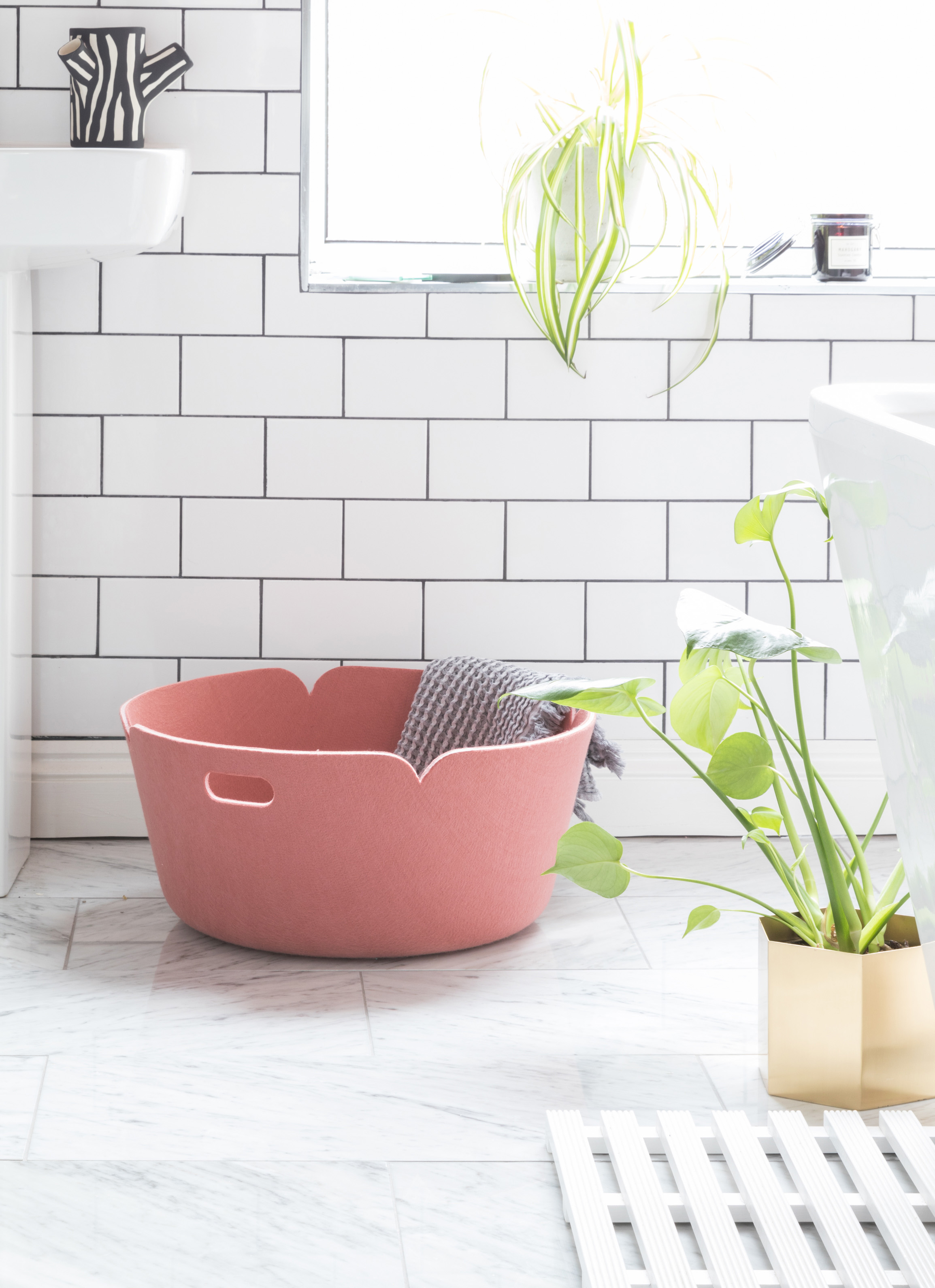
Christina Chrysostomou
Want to know how to wash silk? We've got the 101 on caring for this delicate fabric, so you can rest assured your expensive home textiles will be laundered unscathed.
Figuring out how to do laundry properly is pretty complex as it is, but the good news is, that cleaning this luxe material is not as fiddly as you might have previously thought.
The best news is that you can use your normal washing machine, instead of racking up an expensive professional dry cleaning bill, but you'll need to know what you're doing to save your mommes from a washer massacre.
Martha Stewart says, 'People tend to believe that delicates like silk and cashmere need to be shipped off to the dry cleaners, but you can actually care for your sensuous silky items at home, just as you can with your delicate wool items.'
Depending on which source you consult online, you'll read about all sorts of complicated methods for washing silk, but the truth is: silk is a fabric that doesn't like to be agitated too much and only needs a mild laundry detergent.
So, with that in mind, these are our top tips for washing your silk favorites.

How to wash silk bedding
'Silk bedding is a beautiful material but it takes some proper care and attention to ensure it doesn’t get spoilt in the washing - or worse shrunk!' says James Higgins, CEO of Ethical Bedding, the UK’s only BCorp accredited sustainable bedding company.
Here he outlines three things you should remember when washing silk bedding:
Get small space home decor ideas, celeb inspiration, DIY tips and more, straight to your inbox!
- Ensure silk is laundered separately from other types of bedding, clothes, or bath towels
- Use mesh bags (available from Amazon) when machine washing silk
- Never tumble dry your silk bedding – reserve your dryer for more robust textile materials
How to wash a silk pillowcase
The best silk pillowcases can tame your tresses and even keep your hair from shedding, giving you that 'I woke up like this' feeling all year round.
But as well as washing your pillows once in a while, you should also aim to clean their outer casing as dead skin, dandruff, makeup, and even your multi-product skincare regime can take its toll on your precious pillow slip.

- Turn silk pillowcases inside out before laundering, and place the pillowcase in a mesh laundry bag or even an old pillowcase to protect the silk from tearing and pulling in the washer.
- A mesh wash bag will help protect your sheets from damage.
- We recommend a cold or lukewarm (up to 30 degrees) delicates wash.
- Use a gentle washing powder or liquid detergent without enzymes or bleach – a plant-based eco-friendly laundry detergent may do the job.
- Line dry avoiding direct sunlight.

How to hand wash silk
Some people prefer hand washing their silks, not trusting the washing machine to be gentle enough. If this is your preferred method, you will still need to use the mild detergent described above.
When learning how to handwash clothes, Stewart explains, 'Fill your basin with cool or cold water to help keep the color, then add a gentle detergent. This point is important: Silk is a protein that's a lot like your hair, so treat the fabric like you would your locks-meaning no harsh detergents.'
Here's how to hand wash silk:
- Fill your bath or sink with lukewarm water, add the detergent and gently massage your silk garment.
- Avoid rubbing. When you've rinsed out the detergent, gently squeeze the garment; never wring.
- Silk is fine to dry hanging unless it's a blend, in which case flat drying might be best.
How to wash silk in the machine
Many high-quality, newer washing machines have a silk cycle, but if yours doesn't, just choose the most delicate, shortest cycle with the lowest spin.
This last part is very important: silk will tear easily on very fast spin cycles, and will wrinkle.
Avoid washing silk with cotton clothing and towels, although you should be able to wash it together with wool without any problems. If you'd like to learn how to use a washing machine to clean silk items, mesh laundry bags are only necessary for smaller items such as lingerie and sleep/face masks.

The right detergent to wash silk
This is by far the most important step in achieving the best results when washing silk. Silk has extremely smooth fibers, which is what gives it its natural sheen.
This type of fiber is easily damaged by harsh chemicals or abrasive washing powders, but it equally dislikes being overloaded with moisturizers.
So, whether you wash your silk by hand or in the washing machine, always wash it with specially formulated silk-friendly detergent. It will be pH-neutral and creamy but without overly heavy fabric softeners. We've had particularly good results with The Laundress Delicate Wash, available on Amazon.
'Silk is delicate, so there are various products and harsh detergents you should avoid at all costs to keep your bedding as comfortable as possible' warns Higgins.
'Because silk is a soft, natural fiber, picking the wrong type of detergent can cause the fibers in the fabric to harden, and you can also be left with potentially-uncomfortable residue. While it sounds quite particular, it’s well worth choosing the right detergent to keep your silk in great condition!'
'To maintain the integrity of the silk and ensure fibers remain soft for as long as possible, look out for mild, toxin-free soap with a neutral pH, similar to what you’d use to wash wool.'
'If you spot a stain on your silk pillowcases, you might be tempted to give it a good rub with a cloth. But it’s important to resist this temptation, as you can worsen the situation and damage the fibers in the fabric.'
'Instead, Using your finger gently blot the affected area with a stain solution. If you don’t have any to hand, you can create a simple solution out of a couple of tablespoons of white vinegar and lukewarm water. Afterward, wash your silk pillowcase as you usually would.'
While cleaning with vinegar gets the thumbs up, here are the products you should stay away from when washing silk:
- Using chlorine bleach – bleaching your silk will dissolve the fibers and weaken your fabric. It’ll also cause permanent yellowing and color loss.
- Using fabric softener – because silk is naturally soft, fabric conditioner isn’t necessary when washing your bedding. In fact, it can even be detrimental and leave behind residue.
- Using optical brightener – optical brightener can help some fabrics to retain their color and vibrancy, but, because silk is natural, it won’t have any effect and may even break down the fibers.
- Using laundry additives – anything other than basic silk detergent can start to weaken the fibers in your fabric.
Choosing the right silk wash temperature
Some care labels will tell you to wash your silk cold, but this is a precaution on the part of the manufacturer. Silk is fine to be washed in 30ºC water – though not much warmer than that. Although silk does not get as dirty as cotton clothing, it does absorb sweat and body lotion, and cold water might not cope.
Higgins adds that 'Washing silk in hot or even warm water can cause shrinkage to your bedding. It’s best to hand wash your silk in cold water (anything 30ºC or below) but if you are machine washing then use a delicate cycle with the lowest possible spin setting.'
When hand washing silk, the water should feel lukewarm, never hot to the touch. If in doubt, use a food thermometer you can grab at Amazon or any temperature gauge that can be submerged into the liquid to check the warmth.
Common myths about washing silk
Silk is an expensive and delicate material, and it's worth putting in the effort to wash it correctly. Having said that, it doesn't require nearly the amount of fuss sometimes suggested, and some of those tips might actually do more harm than good.
The following common silk washing myths fall into this category:
- Myth #1: 'Read the label'. Clothing care labels will often say 'do not wash', or 'dry clean only', or 'machine wash cold'. If your garment is 100 per cent silk, there's simply no reason to follow any of those guidelines, and they're there mainly because the manufacturer hasn't tested their garment for color fastness and/or shrinkage. That said, we'd always, always suggest caution for a precious item and make sure you understand the aforementioned washing symbols.
- Myth #2: 'Spot clean your silk': this could do more harm than good, leaving a bigger spot that'll be even more difficult to remove. Never spot clean your silk or use a stain remover to partially clean the item; always wash the whole garment.
- Myth #3: 'Use baby soap to clean your silk': Soap is made with lye and plant fats that can wreak havoc with your silk, removing its sheen and leaving a residue. Do not use soap to wash your silks.
- Myth #4: 'Silk contains natural oils and doesn't need washing'. This is confusing silk with wool. There are no 'natural oils' in silk, and any oils and sweat it absorbs from your skin do need to be washed out. Do wash your silk garments regularly.
Can you iron silk?
Yes, you can iron silk but you must use your steam iron's lowest heat setting to avoid damaging it. If your iron has a silk setting, even better.
Ideally, use a clean, cotton press cloth over the silk to protect it further, or even better steam it instead with a good garment steamer like the Hilife handheld clothing steamer, available on Amazon.
Anna is a professional writer with many years of experience. She has a passion for contemporary home decor and gardening. She covers a range of topics, from practical advice to interior and garden design.
- Christina ChrysostomouFormer acting head ecommerce editor